Comprehensive Case Study: Mrs. Cateline's Healthcare Management
VerifiedAdded on 2022/11/19
|7
|1668
|220
Case Study
AI Summary
This case study focuses on Mrs. Cateline, a 75-year-old woman admitted to the hospital after a fall, suspected of a femur fracture. The assessment reveals a history of hypertension and type II diabetes, alongside obesity (BMI 36.6), high blood pressure (160/100 mmHg), and other concerning symptoms such as a high pulse rate and lack of bowel movements. The case study involves collecting cues, interpreting information, discriminating relevant data, relating cues, inferring potential issues, matching situations to established knowledge, establishing goals for treatment (X-ray, MRI, bed rest, diet, fluids, behavioral therapy), taking actions to facilitate those goals, predicting outcomes, evaluating the effectiveness of interventions, and reflecting on the process. The analysis considers the patient's medications, physical condition, and psychological state, including the recent death of her husband. The treatment plan includes pain management, fluid administration, and behavioral therapy to address stress and depression, with an emphasis on preventing complications and improving Mrs. Cateline's overall health and well-being. The case study also references relevant literature on simulation debriefing, clinical reasoning, and the management of hypertension and diabetes in elderly patients.
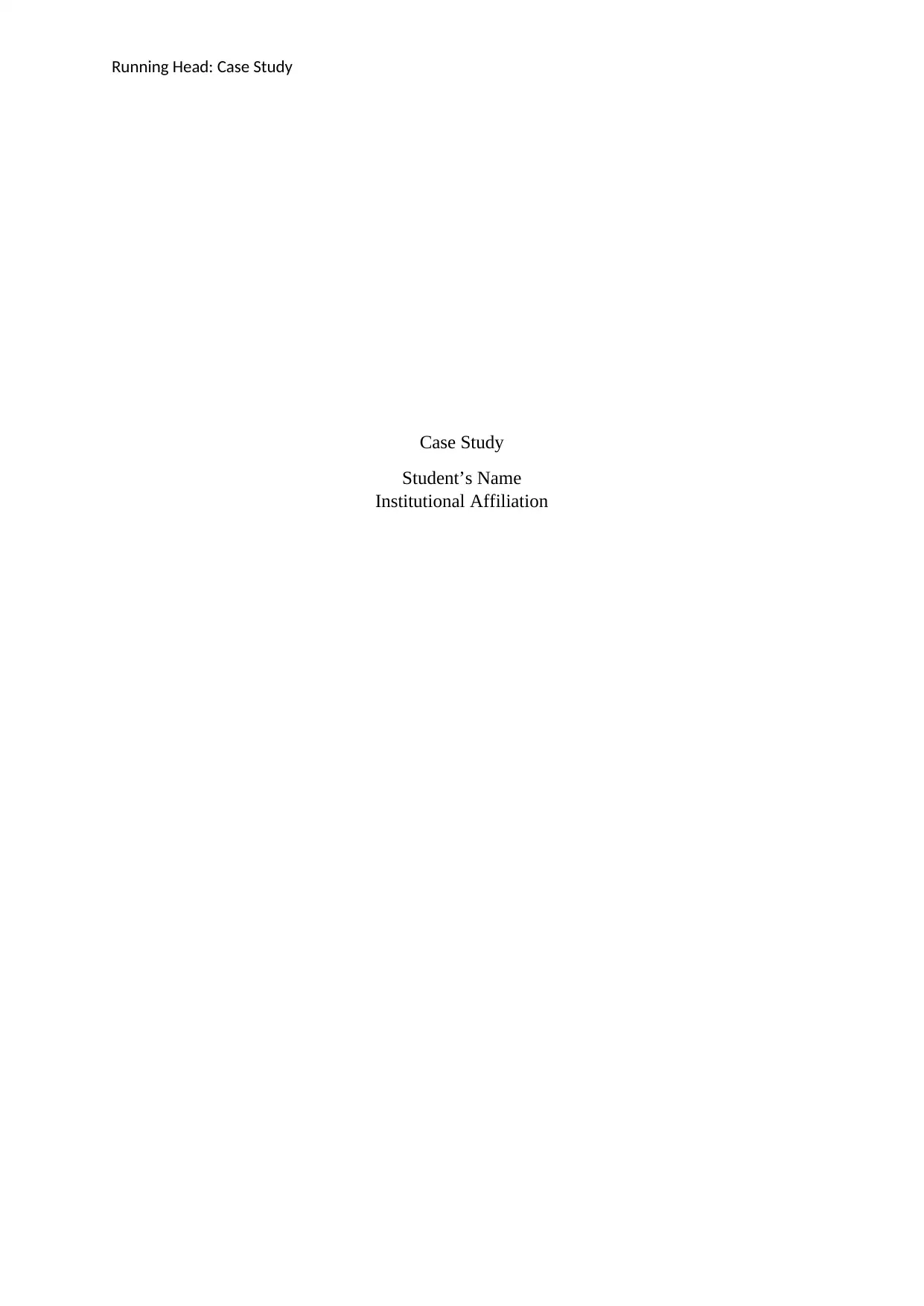
Running Head: Case Study
Case Study
Student’s Name
Institutional Affiliation
Case Study
Student’s Name
Institutional Affiliation
Paraphrase This Document
Need a fresh take? Get an instant paraphrase of this document with our AI Paraphraser
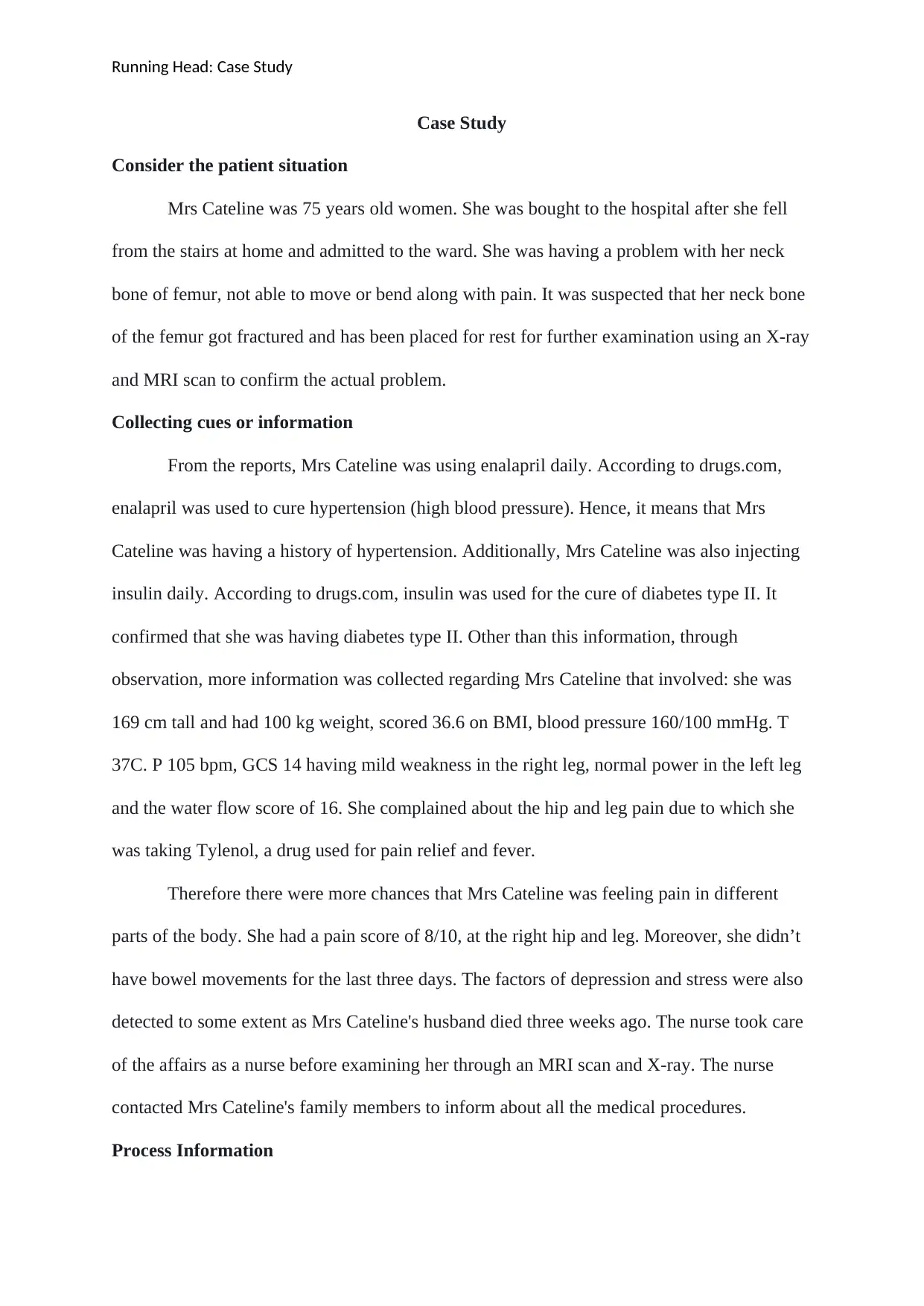
Running Head: Case Study
Case Study
Consider the patient situation
Mrs Cateline was 75 years old women. She was bought to the hospital after she fell
from the stairs at home and admitted to the ward. She was having a problem with her neck
bone of femur, not able to move or bend along with pain. It was suspected that her neck bone
of the femur got fractured and has been placed for rest for further examination using an X-ray
and MRI scan to confirm the actual problem.
Collecting cues or information
From the reports, Mrs Cateline was using enalapril daily. According to drugs.com,
enalapril was used to cure hypertension (high blood pressure). Hence, it means that Mrs
Cateline was having a history of hypertension. Additionally, Mrs Cateline was also injecting
insulin daily. According to drugs.com, insulin was used for the cure of diabetes type II. It
confirmed that she was having diabetes type II. Other than this information, through
observation, more information was collected regarding Mrs Cateline that involved: she was
169 cm tall and had 100 kg weight, scored 36.6 on BMI, blood pressure 160/100 mmHg. T
37C. P 105 bpm, GCS 14 having mild weakness in the right leg, normal power in the left leg
and the water flow score of 16. She complained about the hip and leg pain due to which she
was taking Tylenol, a drug used for pain relief and fever.
Therefore there were more chances that Mrs Cateline was feeling pain in different
parts of the body. She had a pain score of 8/10, at the right hip and leg. Moreover, she didn’t
have bowel movements for the last three days. The factors of depression and stress were also
detected to some extent as Mrs Cateline's husband died three weeks ago. The nurse took care
of the affairs as a nurse before examining her through an MRI scan and X-ray. The nurse
contacted Mrs Cateline's family members to inform about all the medical procedures.
Process Information
Case Study
Consider the patient situation
Mrs Cateline was 75 years old women. She was bought to the hospital after she fell
from the stairs at home and admitted to the ward. She was having a problem with her neck
bone of femur, not able to move or bend along with pain. It was suspected that her neck bone
of the femur got fractured and has been placed for rest for further examination using an X-ray
and MRI scan to confirm the actual problem.
Collecting cues or information
From the reports, Mrs Cateline was using enalapril daily. According to drugs.com,
enalapril was used to cure hypertension (high blood pressure). Hence, it means that Mrs
Cateline was having a history of hypertension. Additionally, Mrs Cateline was also injecting
insulin daily. According to drugs.com, insulin was used for the cure of diabetes type II. It
confirmed that she was having diabetes type II. Other than this information, through
observation, more information was collected regarding Mrs Cateline that involved: she was
169 cm tall and had 100 kg weight, scored 36.6 on BMI, blood pressure 160/100 mmHg. T
37C. P 105 bpm, GCS 14 having mild weakness in the right leg, normal power in the left leg
and the water flow score of 16. She complained about the hip and leg pain due to which she
was taking Tylenol, a drug used for pain relief and fever.
Therefore there were more chances that Mrs Cateline was feeling pain in different
parts of the body. She had a pain score of 8/10, at the right hip and leg. Moreover, she didn’t
have bowel movements for the last three days. The factors of depression and stress were also
detected to some extent as Mrs Cateline's husband died three weeks ago. The nurse took care
of the affairs as a nurse before examining her through an MRI scan and X-ray. The nurse
contacted Mrs Cateline's family members to inform about all the medical procedures.
Process Information
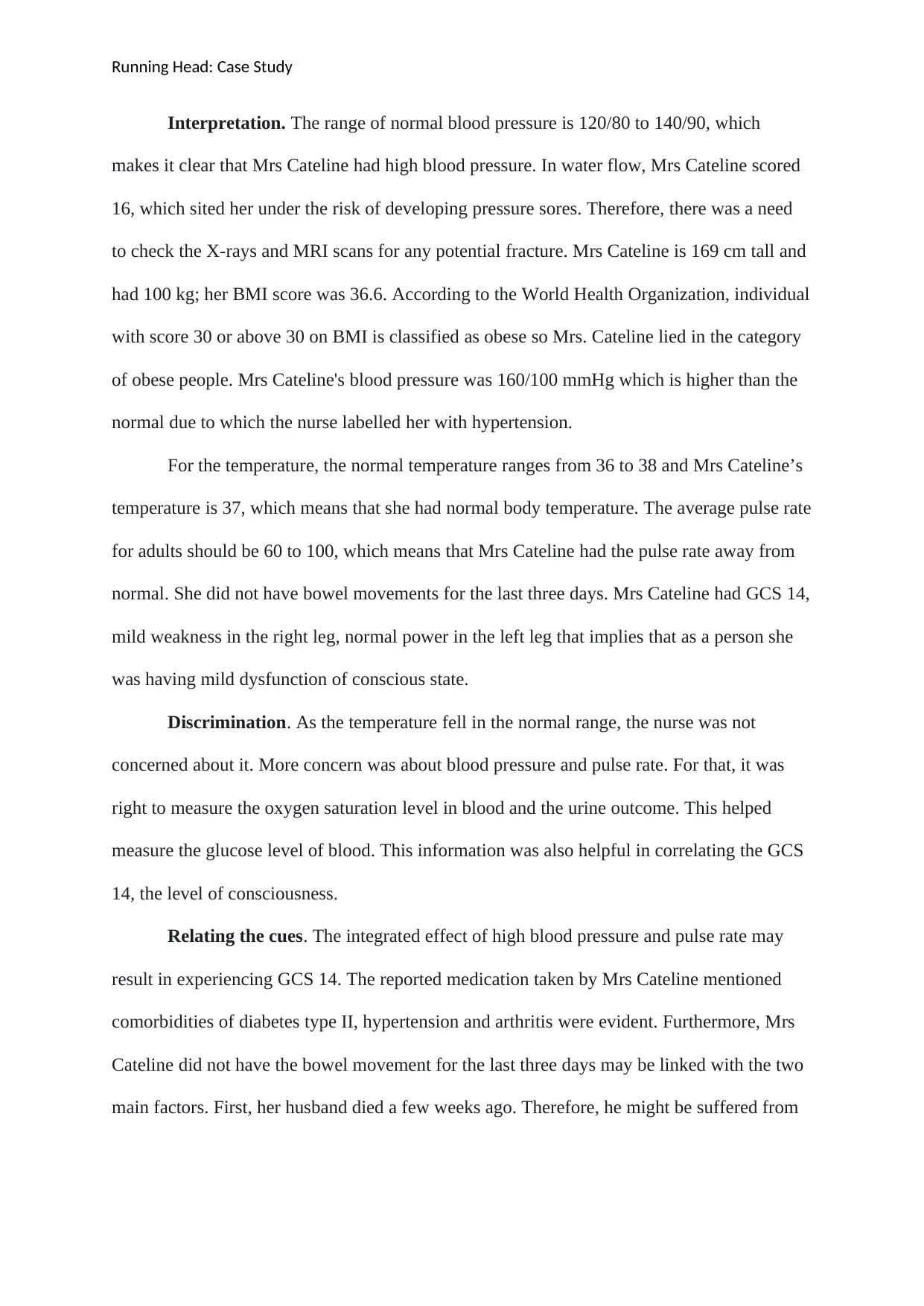
Running Head: Case Study
Interpretation. The range of normal blood pressure is 120/80 to 140/90, which
makes it clear that Mrs Cateline had high blood pressure. In water flow, Mrs Cateline scored
16, which sited her under the risk of developing pressure sores. Therefore, there was a need
to check the X-rays and MRI scans for any potential fracture. Mrs Cateline is 169 cm tall and
had 100 kg; her BMI score was 36.6. According to the World Health Organization, individual
with score 30 or above 30 on BMI is classified as obese so Mrs. Cateline lied in the category
of obese people. Mrs Cateline's blood pressure was 160/100 mmHg which is higher than the
normal due to which the nurse labelled her with hypertension.
For the temperature, the normal temperature ranges from 36 to 38 and Mrs Cateline’s
temperature is 37, which means that she had normal body temperature. The average pulse rate
for adults should be 60 to 100, which means that Mrs Cateline had the pulse rate away from
normal. She did not have bowel movements for the last three days. Mrs Cateline had GCS 14,
mild weakness in the right leg, normal power in the left leg that implies that as a person she
was having mild dysfunction of conscious state.
Discrimination. As the temperature fell in the normal range, the nurse was not
concerned about it. More concern was about blood pressure and pulse rate. For that, it was
right to measure the oxygen saturation level in blood and the urine outcome. This helped
measure the glucose level of blood. This information was also helpful in correlating the GCS
14, the level of consciousness.
Relating the cues. The integrated effect of high blood pressure and pulse rate may
result in experiencing GCS 14. The reported medication taken by Mrs Cateline mentioned
comorbidities of diabetes type II, hypertension and arthritis were evident. Furthermore, Mrs
Cateline did not have the bowel movement for the last three days may be linked with the two
main factors. First, her husband died a few weeks ago. Therefore, he might be suffered from
Interpretation. The range of normal blood pressure is 120/80 to 140/90, which
makes it clear that Mrs Cateline had high blood pressure. In water flow, Mrs Cateline scored
16, which sited her under the risk of developing pressure sores. Therefore, there was a need
to check the X-rays and MRI scans for any potential fracture. Mrs Cateline is 169 cm tall and
had 100 kg; her BMI score was 36.6. According to the World Health Organization, individual
with score 30 or above 30 on BMI is classified as obese so Mrs. Cateline lied in the category
of obese people. Mrs Cateline's blood pressure was 160/100 mmHg which is higher than the
normal due to which the nurse labelled her with hypertension.
For the temperature, the normal temperature ranges from 36 to 38 and Mrs Cateline’s
temperature is 37, which means that she had normal body temperature. The average pulse rate
for adults should be 60 to 100, which means that Mrs Cateline had the pulse rate away from
normal. She did not have bowel movements for the last three days. Mrs Cateline had GCS 14,
mild weakness in the right leg, normal power in the left leg that implies that as a person she
was having mild dysfunction of conscious state.
Discrimination. As the temperature fell in the normal range, the nurse was not
concerned about it. More concern was about blood pressure and pulse rate. For that, it was
right to measure the oxygen saturation level in blood and the urine outcome. This helped
measure the glucose level of blood. This information was also helpful in correlating the GCS
14, the level of consciousness.
Relating the cues. The integrated effect of high blood pressure and pulse rate may
result in experiencing GCS 14. The reported medication taken by Mrs Cateline mentioned
comorbidities of diabetes type II, hypertension and arthritis were evident. Furthermore, Mrs
Cateline did not have the bowel movement for the last three days may be linked with the two
main factors. First, her husband died a few weeks ago. Therefore, he might be suffered from
⊘ This is a preview!⊘
Do you want full access?
Subscribe today to unlock all pages.

Trusted by 1+ million students worldwide
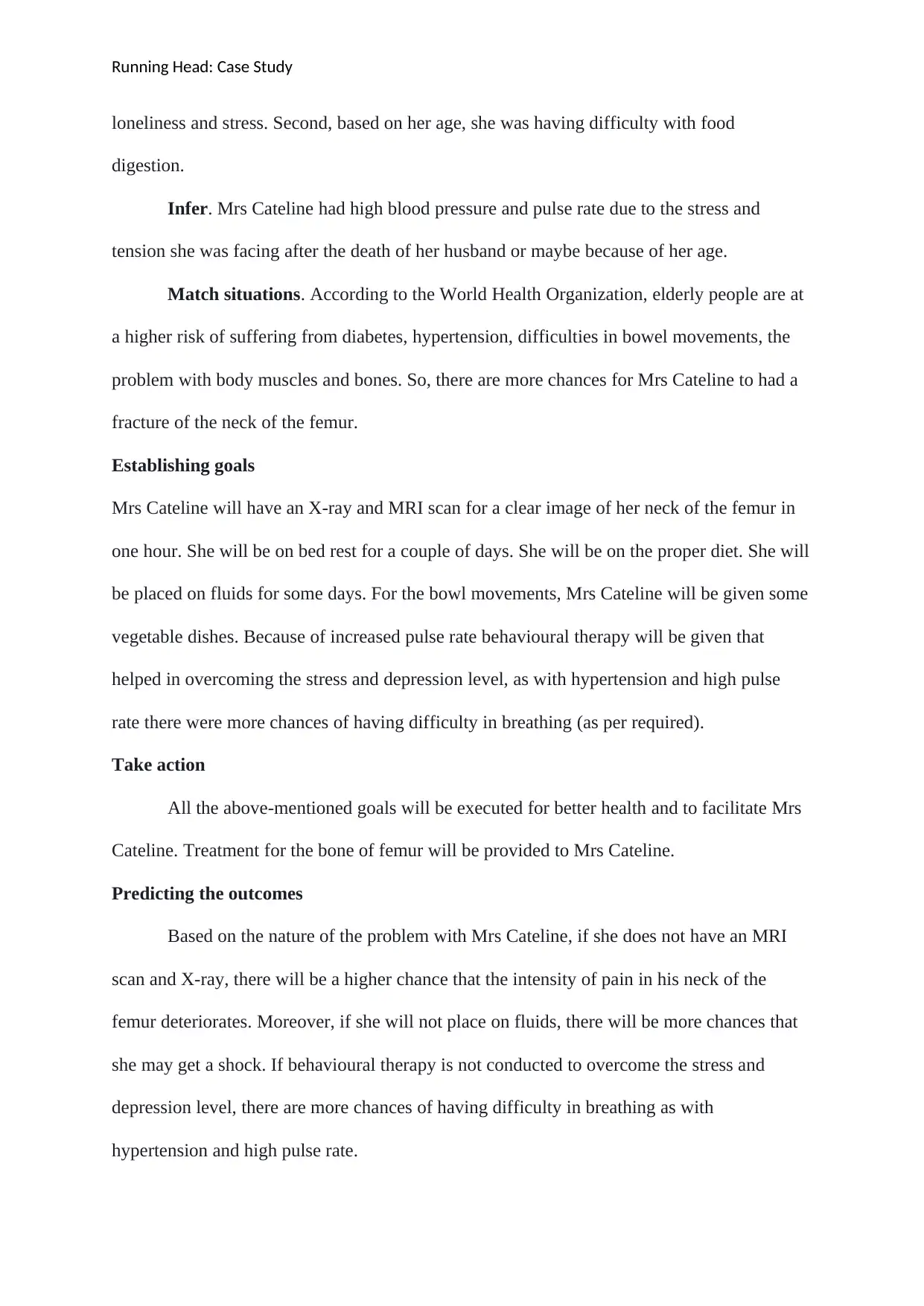
Running Head: Case Study
loneliness and stress. Second, based on her age, she was having difficulty with food
digestion.
Infer. Mrs Cateline had high blood pressure and pulse rate due to the stress and
tension she was facing after the death of her husband or maybe because of her age.
Match situations. According to the World Health Organization, elderly people are at
a higher risk of suffering from diabetes, hypertension, difficulties in bowel movements, the
problem with body muscles and bones. So, there are more chances for Mrs Cateline to had a
fracture of the neck of the femur.
Establishing goals
Mrs Cateline will have an X-ray and MRI scan for a clear image of her neck of the femur in
one hour. She will be on bed rest for a couple of days. She will be on the proper diet. She will
be placed on fluids for some days. For the bowl movements, Mrs Cateline will be given some
vegetable dishes. Because of increased pulse rate behavioural therapy will be given that
helped in overcoming the stress and depression level, as with hypertension and high pulse
rate there were more chances of having difficulty in breathing (as per required).
Take action
All the above-mentioned goals will be executed for better health and to facilitate Mrs
Cateline. Treatment for the bone of femur will be provided to Mrs Cateline.
Predicting the outcomes
Based on the nature of the problem with Mrs Cateline, if she does not have an MRI
scan and X-ray, there will be a higher chance that the intensity of pain in his neck of the
femur deteriorates. Moreover, if she will not place on fluids, there will be more chances that
she may get a shock. If behavioural therapy is not conducted to overcome the stress and
depression level, there are more chances of having difficulty in breathing as with
hypertension and high pulse rate.
loneliness and stress. Second, based on her age, she was having difficulty with food
digestion.
Infer. Mrs Cateline had high blood pressure and pulse rate due to the stress and
tension she was facing after the death of her husband or maybe because of her age.
Match situations. According to the World Health Organization, elderly people are at
a higher risk of suffering from diabetes, hypertension, difficulties in bowel movements, the
problem with body muscles and bones. So, there are more chances for Mrs Cateline to had a
fracture of the neck of the femur.
Establishing goals
Mrs Cateline will have an X-ray and MRI scan for a clear image of her neck of the femur in
one hour. She will be on bed rest for a couple of days. She will be on the proper diet. She will
be placed on fluids for some days. For the bowl movements, Mrs Cateline will be given some
vegetable dishes. Because of increased pulse rate behavioural therapy will be given that
helped in overcoming the stress and depression level, as with hypertension and high pulse
rate there were more chances of having difficulty in breathing (as per required).
Take action
All the above-mentioned goals will be executed for better health and to facilitate Mrs
Cateline. Treatment for the bone of femur will be provided to Mrs Cateline.
Predicting the outcomes
Based on the nature of the problem with Mrs Cateline, if she does not have an MRI
scan and X-ray, there will be a higher chance that the intensity of pain in his neck of the
femur deteriorates. Moreover, if she will not place on fluids, there will be more chances that
she may get a shock. If behavioural therapy is not conducted to overcome the stress and
depression level, there are more chances of having difficulty in breathing as with
hypertension and high pulse rate.
Paraphrase This Document
Need a fresh take? Get an instant paraphrase of this document with our AI Paraphraser
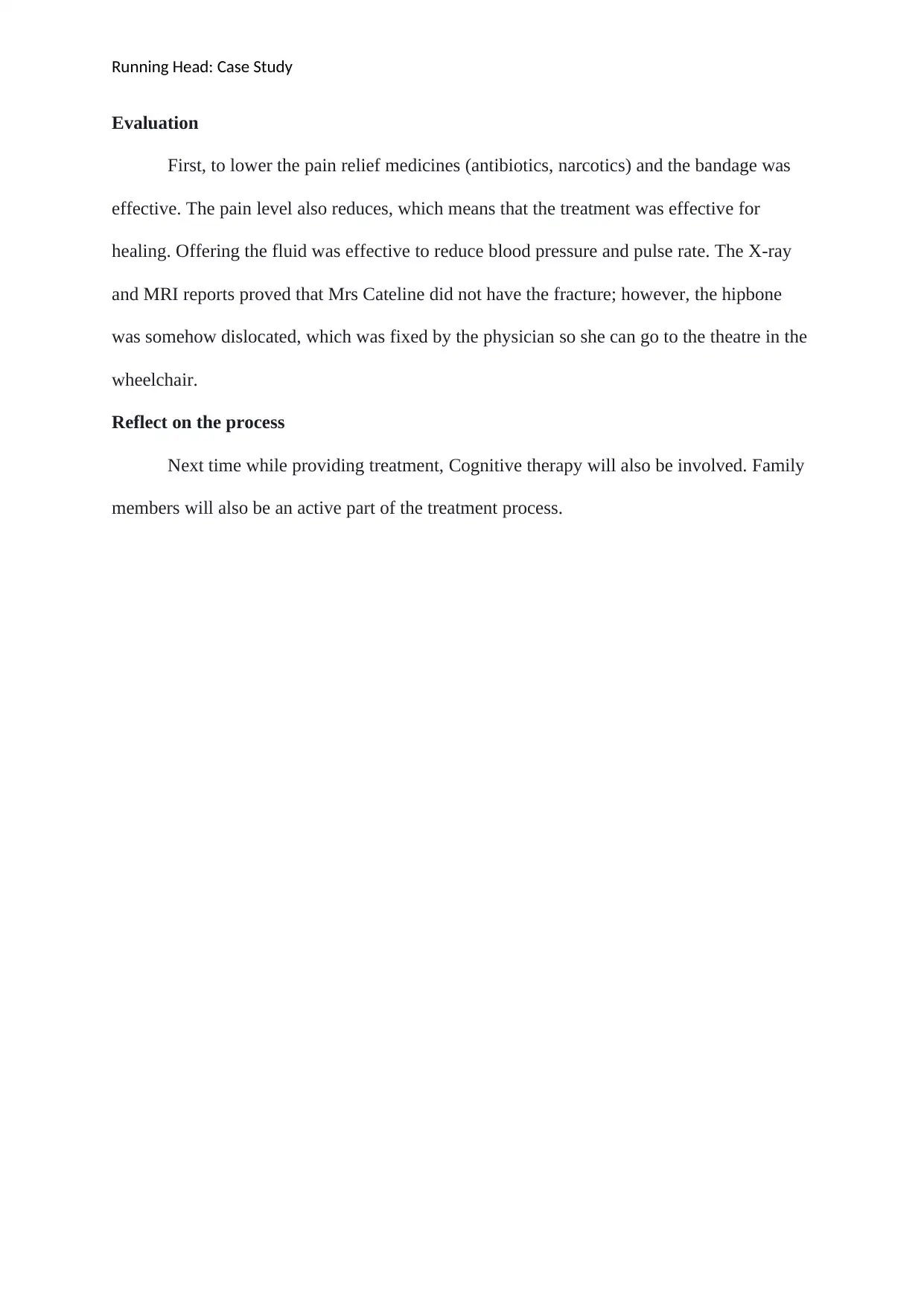
Running Head: Case Study
Evaluation
First, to lower the pain relief medicines (antibiotics, narcotics) and the bandage was
effective. The pain level also reduces, which means that the treatment was effective for
healing. Offering the fluid was effective to reduce blood pressure and pulse rate. The X-ray
and MRI reports proved that Mrs Cateline did not have the fracture; however, the hipbone
was somehow dislocated, which was fixed by the physician so she can go to the theatre in the
wheelchair.
Reflect on the process
Next time while providing treatment, Cognitive therapy will also be involved. Family
members will also be an active part of the treatment process.
Evaluation
First, to lower the pain relief medicines (antibiotics, narcotics) and the bandage was
effective. The pain level also reduces, which means that the treatment was effective for
healing. Offering the fluid was effective to reduce blood pressure and pulse rate. The X-ray
and MRI reports proved that Mrs Cateline did not have the fracture; however, the hipbone
was somehow dislocated, which was fixed by the physician so she can go to the theatre in the
wheelchair.
Reflect on the process
Next time while providing treatment, Cognitive therapy will also be involved. Family
members will also be an active part of the treatment process.
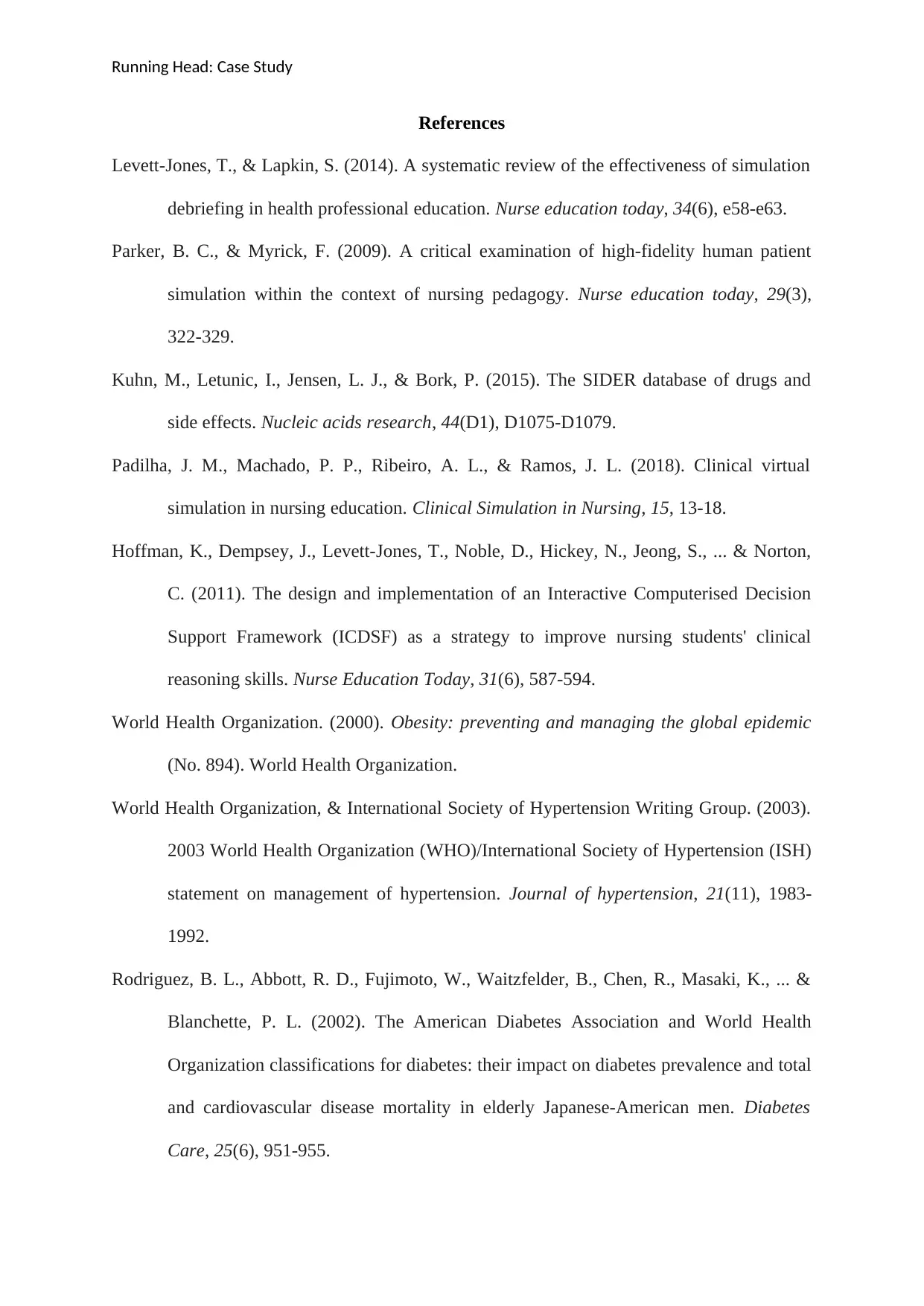
Running Head: Case Study
References
Levett-Jones, T., & Lapkin, S. (2014). A systematic review of the effectiveness of simulation
debriefing in health professional education. Nurse education today, 34(6), e58-e63.
Parker, B. C., & Myrick, F. (2009). A critical examination of high-fidelity human patient
simulation within the context of nursing pedagogy. Nurse education today, 29(3),
322-329.
Kuhn, M., Letunic, I., Jensen, L. J., & Bork, P. (2015). The SIDER database of drugs and
side effects. Nucleic acids research, 44(D1), D1075-D1079.
Padilha, J. M., Machado, P. P., Ribeiro, A. L., & Ramos, J. L. (2018). Clinical virtual
simulation in nursing education. Clinical Simulation in Nursing, 15, 13-18.
Hoffman, K., Dempsey, J., Levett-Jones, T., Noble, D., Hickey, N., Jeong, S., ... & Norton,
C. (2011). The design and implementation of an Interactive Computerised Decision
Support Framework (ICDSF) as a strategy to improve nursing students' clinical
reasoning skills. Nurse Education Today, 31(6), 587-594.
World Health Organization. (2000). Obesity: preventing and managing the global epidemic
(No. 894). World Health Organization.
World Health Organization, & International Society of Hypertension Writing Group. (2003).
2003 World Health Organization (WHO)/International Society of Hypertension (ISH)
statement on management of hypertension. Journal of hypertension, 21(11), 1983-
1992.
Rodriguez, B. L., Abbott, R. D., Fujimoto, W., Waitzfelder, B., Chen, R., Masaki, K., ... &
Blanchette, P. L. (2002). The American Diabetes Association and World Health
Organization classifications for diabetes: their impact on diabetes prevalence and total
and cardiovascular disease mortality in elderly Japanese-American men. Diabetes
Care, 25(6), 951-955.
References
Levett-Jones, T., & Lapkin, S. (2014). A systematic review of the effectiveness of simulation
debriefing in health professional education. Nurse education today, 34(6), e58-e63.
Parker, B. C., & Myrick, F. (2009). A critical examination of high-fidelity human patient
simulation within the context of nursing pedagogy. Nurse education today, 29(3),
322-329.
Kuhn, M., Letunic, I., Jensen, L. J., & Bork, P. (2015). The SIDER database of drugs and
side effects. Nucleic acids research, 44(D1), D1075-D1079.
Padilha, J. M., Machado, P. P., Ribeiro, A. L., & Ramos, J. L. (2018). Clinical virtual
simulation in nursing education. Clinical Simulation in Nursing, 15, 13-18.
Hoffman, K., Dempsey, J., Levett-Jones, T., Noble, D., Hickey, N., Jeong, S., ... & Norton,
C. (2011). The design and implementation of an Interactive Computerised Decision
Support Framework (ICDSF) as a strategy to improve nursing students' clinical
reasoning skills. Nurse Education Today, 31(6), 587-594.
World Health Organization. (2000). Obesity: preventing and managing the global epidemic
(No. 894). World Health Organization.
World Health Organization, & International Society of Hypertension Writing Group. (2003).
2003 World Health Organization (WHO)/International Society of Hypertension (ISH)
statement on management of hypertension. Journal of hypertension, 21(11), 1983-
1992.
Rodriguez, B. L., Abbott, R. D., Fujimoto, W., Waitzfelder, B., Chen, R., Masaki, K., ... &
Blanchette, P. L. (2002). The American Diabetes Association and World Health
Organization classifications for diabetes: their impact on diabetes prevalence and total
and cardiovascular disease mortality in elderly Japanese-American men. Diabetes
Care, 25(6), 951-955.
⊘ This is a preview!⊘
Do you want full access?
Subscribe today to unlock all pages.

Trusted by 1+ million students worldwide

Running Head: Case Study
Dayhoff, N. E., Suhrheinrich, J., Wigglesworth, J., Topp, R., & Moore, S. (1998). Balance
and muscle strength as predictors of frailty among older adults. Journal of
gerontological nursing, 24(7), 18-27.
Dayhoff, N. E., Suhrheinrich, J., Wigglesworth, J., Topp, R., & Moore, S. (1998). Balance
and muscle strength as predictors of frailty among older adults. Journal of
gerontological nursing, 24(7), 18-27.
1 out of 7
Related Documents
Your All-in-One AI-Powered Toolkit for Academic Success.
+13062052269
info@desklib.com
Available 24*7 on WhatsApp / Email
![[object Object]](/_next/static/media/star-bottom.7253800d.svg)
Unlock your academic potential
Copyright © 2020–2025 A2Z Services. All Rights Reserved. Developed and managed by ZUCOL.





